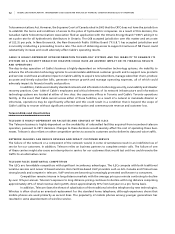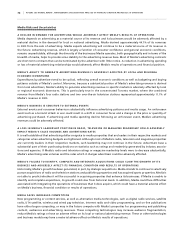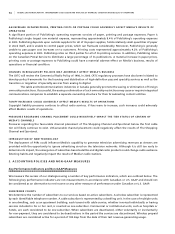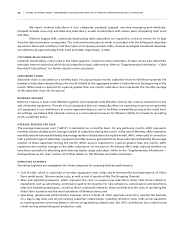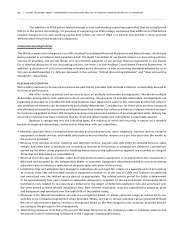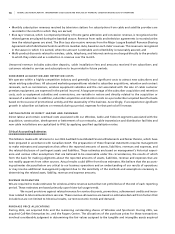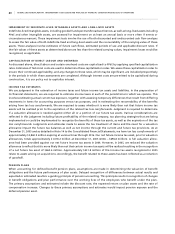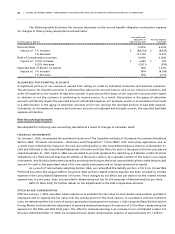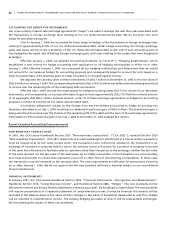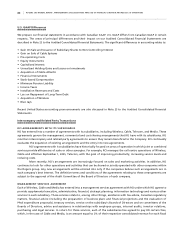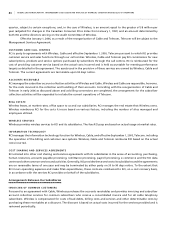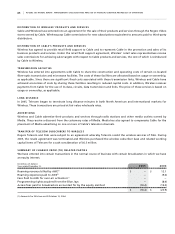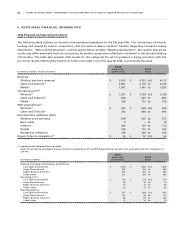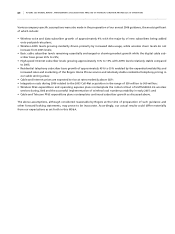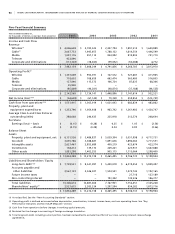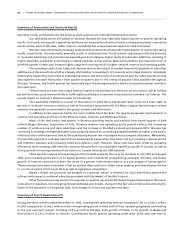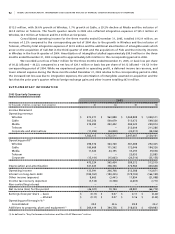Rogers 2005 Annual Report Download - page 86
Download and view the complete annual report
Please find page 86 of the 2005 Rogers annual report below. You can navigate through the pages in the report by either clicking on the pages listed below, or by using the keyword search tool below to find specific information within the annual report.
82 ROGERS 2005 ANNUAL REPORT . MANAGEMENT’S DISCUSSION AND ANALYSIS OF FINANCIAL CONDITION AND RESULTS OF OPERATIONS
AC C O UN T IN G F O R D E RI V AT I V E I NS T RU M E NT S
Our cross-currency interest rate exchange agreements (“swaps”) are used to manage the cash flow risks associated with
the fluctuations in foreign exchange rates relating to our U.S. dollar-denominated debt. We do not enter into such
swaps for speculative purposes.
Prior to January 1, 2004, we accounted for these swaps as hedges of the fluctuations in foreign exchange rates
relating to approximately 67.8% of our U.S. dollar-denominated debt. Under hedge accounting, the foreign exchange
gains and losses arising on the translation of the U.S. dollar-denominated debt at the end of each accounting period
was hedged by the equal and offsetting foreign exchange gains and losses relating to the swaps that were designated
as hedges.
Effective January 1, 2004, we adopted Accounting Guideline 13 (“AcG-13”), “Hedging Relationships” which
established a new criteria for hedge accounting with application to all hedging relationships in effect on or after
January 1, 2004. Effective January 1, 2004, we re-assessed all our hedging relationships and determined that we would
not account for our swaps as hedges for accounting purposes and consequently began to account for such swaps on a
mark-to-market basis, with resulting gains or losses recorded in or charged against income.
We adjusted the carrying value of these instruments of $338.1 million at December 31, 2003 to the fair value of
$385.3 million on January 1, 2004. The corresponding transitional loss of $47.2 million was deferred and was being amortized
to income over the remaining life of the underlying debt instruments.
Effective July 1, 2004, we met the requirements for hedge accounting under AcG-13 for certain of our derivative
instruments, and consequently, on a prospective basis, began to treat approximately US$2,773.4 million notional amount
of an aggregate US$2,885.3 million notional amount, or 96.1% of these exchange agreements, as hedges for accounting
purposes on US$2,773.4 million of U.S. dollar-denominated debt.
A transition adjustment arising on the change from mark-to-market accounting to hedge accounting was
therefore calculated as at July 1, 2004, resulting in a deferred transitional gain of $80.0 million. This transitional gain is
being amortized to income over the shorter of the remaining life of the debt and the term of the exchange agreements.
Amortization of the transitional gain from July 1, 2004 to December 31, 2004 totalled $6.5 million.
Recent Canadian Accounting Pronouncements
NO N - MO N ET A RY T RA N SA C TI O N S
In 2005, the CICA issued Handbook Section 3831 “Non-monetary transactions” (“CICA 3831”), replaced Section 3830
“Non-monetary transactions”. CICA 3831 requires that an asset exchanged or transferred in a non-monetary transaction
must be measured at its fair value except when: the transaction lacks commercial substance; the transaction is an
exchange of a product or property held for sale in the ordinary course of business for a product or property to be sold
in the same line of business to facilitate sales to customers other than the parties to the exchange; neither the fair value
of the asset received nor the fair value of the asset given up is reliably measurable; or the transaction is a non-monetary
non-reciprocal transfer to owners that represents a spin-off or other form of restructuring or liquidation. In these cases
the transaction must be measured at the carrying value. The new requirements are effective for transactions occurring
on or after January 1, 2006. We do not expect that this new standard will have a material impact on our consolidated
financial statements.
FI N A NC I AL IN S T RU M EN T S
In January 2005, the CICA issued Handbook Section 3855, “Financial Instruments – Recognition and Measurement”,
Handbook Section 1530, “Comprehensive Income”, and Handbook Section 3865, “Hedges”. The new standards will be
effective for interim and annual financial statements commencing in 2007. Earlier adoption is permitted. The new standards
will require presentation of a separate statement of comprehensive income. Derivative financial instruments will be
recorded in the balance sheet at fair value and the changes in fair value of derivatives designated as cash flow hedges
will be reported in comprehensive income. The existing hedging principles of AcG-13 will be substantially unchanged.
We are assessing the impact of these new standards.


